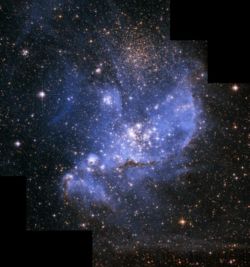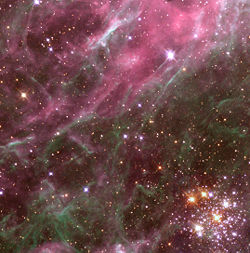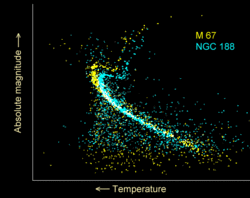Open cluster
2008/9 Schools Wikipedia Selection. Related subjects: Space (Astronomy)
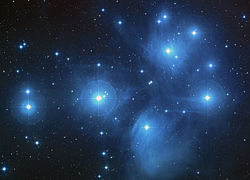
An open cluster is a group of up to a few thousand stars that were formed from the same giant molecular cloud, and are still loosely gravitationally bound to each other. In contrast, globular clusters are very tightly bound by gravity. Open clusters have been found only in spiral and irregular galaxies, in which active star formation is occurring. They are usually less than a few hundred million years old: they become disrupted by close encounters with other clusters and clouds of gas as they orbit the galactic centre, as well as losing cluster members through internal close encounters.
Young open clusters may still be contained within the molecular cloud from which they formed, illuminating it to create an H II region. Over time, radiation pressure from the cluster will disperse the molecular cloud. Typically, about 10% of the mass of a gas cloud will coalesce into stars before radiation pressure drives the rest away.
Open clusters are very important objects in the study of stellar evolution. Because the stars are all of very similar age and chemical composition, the effects of other more subtle variables on the properties of stars are much more easily studied than they are for isolated stars.
Historical observations
The most prominent open clusters such as the Pleiades have been known and recognised as groups of stars since antiquity. Others were known as fuzzy patches of light, but had to wait until the invention of the telescope to be resolved into their constituent stars. Telescopic observations revealed two distinct types of clusters, one of which contained thousands of stars in a regular spherical distribution and was found preferentially towards the centre of the Milky Way, and the other of which consisted of a generally sparser population of stars in a more irregular shape and found all over the sky. Astronomers dubbed the former globular clusters, and the latter open clusters. Open clusters are also occasionally referred to as galactic clusters, because they are almost exclusively found in the plane of the Milky Way, as discussed below.
It was realised early on that the stars in the open clusters were physically related. The Reverend John Michell calculated in 1767 that the probability of even just one group of stars like the Pleiades being the result of a chance alignment as seen from Earth was just 1 in 496,000. As astrometry became more accurate, cluster stars were found to share a common proper motion through space, while spectroscopic measurements revealed common radial velocities, thus showing that the clusters consist of stars born at the same time and bound together as a group.
While open clusters and globular clusters form two fairly distinct groups, there may not be a great deal of difference in appearance between a very sparse globular cluster and a very rich open cluster. Some astronomers believe the two types of star clusters form via the same basic mechanism, with the difference being that the conditions which allowed the formation of the very rich globular clusters containing hundreds of thousands of stars no longer prevail in our galaxy.
Formation
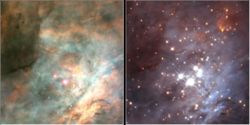
A large fraction of stars are originally formed in multiple systems because only a cloud of gas containing many times the mass of the Sun will be heavy enough to collapse under its own gravity, but such a heavy cloud cannot collapse into a single star.
The formation of an open cluster begins with the collapse of part of a giant molecular cloud, a cold dense cloud of gas containing up to many thousands of times the mass of the Sun. Many factors may trigger the collapse of a giant molecular cloud (or part of it) and a burst of star formation which will result in an open cluster, including shock waves from a nearby supernova and gravitational interactions. Once a giant molecular cloud begins to collapse, star formation proceeds via successive fragmentations of the cloud into smaller and smaller clumps, resulting eventually in the formation of up to several thousand stars. In our own galaxy, the formation rate of open clusters is estimated to be one every few thousand years.
Once star formation has begun, the hottest and most massive stars (known as OB stars) will emit copious amounts of ultraviolet radiation. This radiation rapidly ionizes the surrounding gas of the giant molecular cloud, forming an H II region. Stellar winds from the massive stars and radiation pressure begin to drive away the gases; after a few million years the cluster will experience its first supernovae, which will also expel gas from the system. After a few tens of millions of years, the cluster will be stripped of gas and no further star formation will take place. Typically, less than 10% of the gas originally in the cluster will form into stars before it is dissipated.
Another view of cluster formation is that they form rapidly out of a contracting molecular cloud core and once the massive stars begin to shine they expel the residual gas with the sound speed of the hot ionised gas. From the time of start of cloud-core contraction to gas expulsion takes typically not more than one to three million years. As only 30 to 40 per cent of the gas in the cloud core forms stars, the process of residual gas expulsion is highly damaging to the cluster which loses many and perhaps all of its stars . All clusters thus suffer significant infant weight loss, while a large fraction undergo infant mortality. The young stars so released from their natal cluster become part of the Galactic field population. Because most if not all stars form clustered, star clusters are to be viewed the fundamental building blocks of galaxies. The violent gas-expulsion events that shape and destroy many star clusters at birth leave their imprint in the morphological and kinematical structures of galaxies .
It is common for two or more separate open clusters to form out of the same molecular cloud. In the Large Magellanic Cloud, both Hodge 301 and R136 are forming from the gases of the Tarantula Nebula, while in our own galaxy, tracing back the motion through space of the Hyades and Praesepe, two prominent nearby open clusters, suggests that they formed in the same cloud about 600 million years ago.
Sometimes, two clusters born at the same time will form a binary cluster. The best known example in the Milky Way is the Double Cluster of h Persei and χ Persei, but at least 10 more double clusters are known to exist. Many more are known in the Small and Large Magellanic Clouds — they are easier to detect in external systems than in our own galaxy because projection effects can cause unrelated clusters within the Milky Way to appear close to each other.
Morphology and classification
Open clusters range from very sparse clusters with only a few members to large agglomerations containing thousands of stars. They usually consist of quite a distinct dense core, surrounded by a more diffuse 'corona' of cluster members. The core is typically about 3–4 light years across, with the corona extending to about 20 light years from the cluster centre. Typical star densities in the centre of a cluster are about 1.5 stars per cubic light year (the stellar density near the sun is about 0.003 star per cubic light year).
Open clusters are often classified according to a scheme developed by Robert Trumpler in 1930. The Trumpler scheme gives a cluster a three part designation, with a Roman numeral from I-IV indicating its concentration and detachment from the surrounding star field (from strongly to weakly concentrated), an Arabic numeral from 1 to 3 indicating the range in brightness of members (from small to large range), and p, m or r to indication whether the cluster is poor, medium or rich in stars. An 'n' is appended if the cluster lies within nebulosity.
Under the Trumpler scheme, the Pleiades are classified as I3rn (strongly concentrated and richly populated with nebulosity present), while the nearby Hyades are classified as II3m (more dispersed, and with fewer members).
Numbers and distribution
There are over 1,000 known open clusters in our galaxy, but the true total may be up to ten times higher than that. In spiral galaxies, open clusters are invariably found in the spiral arms where gas densities are highest and so most star formation occurs, and clusters usually disperse before they have had time to travel beyond their spiral arm. Open clusters are strongly concentrated close to the galactic plane, with a scale height in our galaxy of about 180 light years, compared to a galactic radius of approximately 100,000 light years.
In irregular galaxies, open clusters may be found throughout the galaxy, although their concentration is highest where the gas density is highest. Open clusters are not seen in elliptical galaxies: star formation ceased many millions of years ago in ellipticals, and so the open clusters which were originally present have long since dispersed.
In our galaxy, the distribution of clusters depends on age, with older clusters being preferentially found at greater distances from the galactic centre. Tidal forces are stronger nearer the centre of the galaxy, increasing the rate of disruption of clusters, and also the giant molecular clouds which cause the disruption of clusters are concentrated towards the inner regions of the galaxy, so clusters in the inner regions of the galaxy tend to get dispersed at a younger age than their counterparts in the outer regions.
Stellar composition
Because open clusters tend to be dispersed before most of their stars reach the end of their lives, the light from them tends to be dominated by the young, hot blue stars. These stars are the most massive, and have the shortest lives of a few tens of millions of years. The older open clusters tend to contain more yellow stars.
Some open clusters contain hot blue stars which seem to be much younger than the rest of the cluster. These blue stragglers are also observed in globular clusters, and in the very dense cores of globulars they are believed to arise when stars collide, forming a much hotter, more massive star. However, the stellar density in open clusters is much lower than that in globular clusters, and stellar collisions cannot explain the numbers of blue stragglers observed. Instead, it is thought that most of them probably originate when dynamical interactions with other stars cause a binary system to coalesce into one star.
Once they have exhausted their supply of hydrogen through nuclear fusion, medium to low mass stars shed their outer layers to form a planetary nebula and evolve into white dwarfs. While most clusters become dispersed before a large proportion of their members have reached the white dwarf stage, the number of white dwarfs in open clusters is still generally much lower than would be expected, given the age of the cluster and the expected initial mass distribution of the stars. One possible explanation for the lack of white dwarfs is that when a red giant expels its outer layers to become a planetary nebula, a slight asymmetry in the loss of material could give the star a 'kick' of a few kilometres per second, enough to eject it from the cluster.
Eventual fate

Many open clusters are inherently unstable, with a small enough mass that the escape velocity of the system is lower than the average velocity of the constituent stars. These clusters will rapidly disperse within a few million years. In many cases, the stripping away of the gas from which the cluster formed by the radiation pressure of the hot young stars reduces the cluster mass enough to allow rapid dispersal.
Clusters which have enough mass to be gravitationally bound once the surrounding nebula has evaporated can remain distinct for many tens of millions of years, but over time internal and external processes tend also to disperse them. Internally, close encounters between members of the cluster will often result in the velocity of one being increased to beyond the escape velocity of the cluster, which results in the gradual 'evaporation' of cluster members.
Externally, about every half-billion years or so an open cluster tends to be disturbed by external factors such as passing close to or through a molecular cloud. The gravitational tidal forces generated by such an encounter tend to disrupt the cluster. Eventually, the cluster becomes a stream of stars, not close enough to be a cluster but all related and moving in similar directions at similar speeds. The timescale over which a cluster disrupts depends on its initial stellar density, with more tightly packed clusters persisting for longer. Estimated cluster half lives, after which half the original cluster members will have been lost, range from 150–800 million years, depending on the original density.
After a cluster has become gravitationally unbound, many of its constituent stars will still be moving through space on similar trajectories, in what is known as a stellar association, moving cluster or moving group. Several of the brightest stars in the 'Plough' of Ursa Major are former members of an open cluster which now form such an association, in this case, the Ursa Major moving group. Eventually their slightly different relative velocities will see them scattered throughout the galaxy. A larger cluster is then known as a stream, if we discover the similar velocities and ages of otherwise unrelated stars.
Studying stellar evolution
When a Hertzsprung-Russell diagram is plotted for an open cluster, most stars lie on the main sequence. The most massive stars have begun to evolve away from the main sequence and are becoming red giants; the position of the turn-off from the main sequence can be used to estimate the age of the cluster.
Because the stars in an open cluster are all at roughly the same distance from Earth, and were born at roughly the same time from the same raw material, the differences in apparent brightness among cluster members is due only to their mass. This makes open clusters very useful in the study of stellar evolution, because when comparing one star to another, many of the variable parameters are fixed.
The study of the abundances of lithium and beryllium in open cluster stars can give important clues about the evolution of stars and their interior structures. While hydrogen nuclei cannot fuse to form helium until the temperature reaches about 10 million K, lithium and beryllium are destroyed at temperatures of 2.5 million K and 3.5 million K respectively. This means that their abundances depend strongly on how much mixing occurs in stellar interiors. By studying their abundances in open cluster stars, variables such as age and chemical composition are fixed.
Studies have shown that the abundances of these light elements are much lower than models of stellar evolution predict. While the reason for this underabundance is not yet fully understood, one possibility is that convection in stellar interiors can 'overshoot' into regions where radiation is normally the dominant mode of energy transport.
Open clusters and the astronomical distance scale
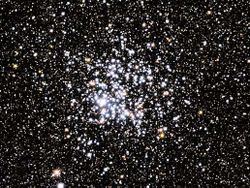
Determining the distances to astronomical objects is crucial to understanding them, but the vast majority of objects are too far away for their distances to be directly determined. Calibration of the astronomical distance scale relies on a sequence of indirect and sometimes uncertain measurements relating the closest objects, for which distances can be directly measured, to increasingly distant objects. Open clusters are a crucial step in this sequence.
The closest open clusters can have their distance measured directly by one of two methods. First, the parallax (the small change in apparent position over the course of a year caused by the Earth moving from one side of its orbit around the Sun to the other) of stars in close open clusters can be measured, like other individual stars. Clusters such as the Pleiades, Hyades and a few others within about 500 light years are close enough for this method to be viable, and results from the Hipparcos position-measuring satellite yielded accurate distances for several clusters.
The other direct method is the so-called moving cluster method. This relies on the fact that the stars of a cluster share a common motion through space. Measuring the proper motions of cluster members and plotting their apparent motions across the sky will reveal that they converge on a vanishing point. The radial velocity of cluster members can be determined from Doppler shift measurements of their spectra, and once the radial velocity, proper motion and angular distance from the cluster to its vanishing point are known, simple trigonometry will reveal the distance to the cluster. The Hyades are the best known application of this method, which reveals their distance to be 46.3 parsecs.
Once the distances to nearby clusters have been established, further techniques can extend the distance scale to more distant clusters. By matching the main sequence on the Hertzsprung-Russell diagram for a cluster at a known distance with that of a more distant cluster, the distance to the more distant cluster can be estimated. The nearest open cluster is the Hyades: the stellar association consisting of most of the Plough stars is at about half the distance of the Hyades, but is a stellar association rather than an open cluster as the stars are not gravitationally bound to each other. The most distant known open cluster in our galaxy is Berkeley 29, at a distance of about 15,000 parsecs. Open clusters are also easily detected in many of the galaxies of the Local Group.
Accurate knowledge of open cluster distances is vital for calibrating the period-luminosity relationship shown by variable stars such as cepheid and RR Lyrae stars, which allows them to be used as standard candles. These luminous stars can be detected at great distances, and are then used to extend the distance scale to nearby galaxies in the Local Group.

